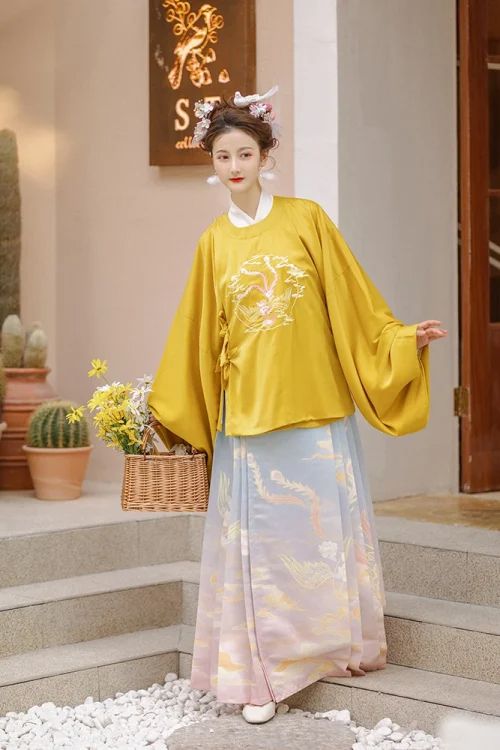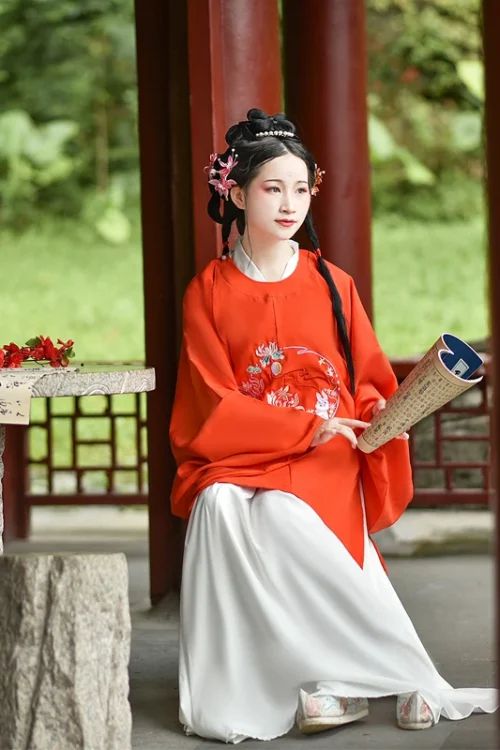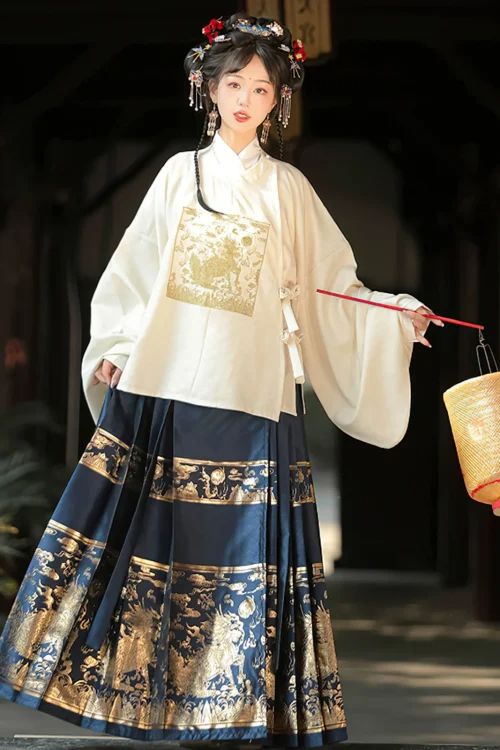The Intricate Embroidery and Delicate Silks of Ming-Dynastie Hanfu
Cultural Legacy
The Ming Dynasty, renowned for its cultural and artistic achievements, left an enduring legacy in the realm of fashion through its exquisite Hanfu. This traditional Chinese attire, characterized by its bold elegance, has captivated the hearts of fashion enthusiasts for centuries.

Meticulous Craftsmanship
The Ming Dynasty Hanfu is a testament to the artisans’ meticulous craftsmanship. Its intricate embroidery, a hallmark of the era, adorns the garments with vibrant hues and intricate patterns. Flowers, birds, and auspicious symbols dance across the fabric, creating a tapestry of beauty that evokes the grandeur of the Ming court.
Luxurious Fabrics
Complementing the embroidery is the use of delicate silks. The finest silk, known as “cloud brocade,” was reserved for the imperial family and high-ranking officials. Its ethereal texture and shimmering surface lend an air of opulence to the Hanfu, making it a symbol of status and refinement.
Reflection of Cultural Values
The Ming Dynasty Hanfu is not merely a fashion statement but also a reflection of the era’s cultural values. The garments’ flowing lines and graceful silhouettes embody the Confucian ideals of harmony and balance. The wide sleeves, known as “horse-hoof sleeves,” symbolize freedom and movement, while the long, trailing skirts represent elegance and femininity.
Timeless Inspiration
The Ming Dynasty Hanfu has transcended time, inspiring contemporary fashion designers and enthusiasts alike. Its bold colors, intricate embroidery, and delicate silks continue to captivate the imagination, making it a timeless fashion statement that celebrates the rich cultural heritage of China.
Living Tradition
Today, the Ming Dynasty Hanfu is not only a historical artifact but also a living tradition. It is worn by enthusiasts at cultural events, festivals, and even in everyday life. Its enduring popularity is a testament to the beauty and cultural significance of this exquisite attire.
Artistic Elegance
As we delve into the intricate embroidery and delicate silks of the Ming Dynasty Hanfu, we uncover a world of artistry and elegance that has stood the test of time. This timeless fashion statement continues to inspire and captivate, serving as a reminder of the rich cultural heritage that shapes our world today.
The Cultural Significance and Symbolism of Ming Dynasty Hanfu
A Flourishing Period
The Ming Dynasty, a period of cultural and artistic flourishing in Chinese history, left an enduring legacy in the form of its exquisite Hanfu, a traditional form of clothing that embodies both elegance and boldness. Hanfu, with its intricate designs and flowing silhouettes, transcended mere fashion and became a symbol of cultural identity and social status.

Vibrant Colors
The Ming Dynasty Hanfu was characterized by its vibrant colors, often featuring hues of red, yellow, and blue. These colors were not merely decorative but held symbolic meanings. Red, for instance, represented auspiciousness and joy, while yellow was reserved for the emperor and his court. The use of contrasting colors created a striking visual effect, highlighting the wearer’s individuality and status.
Elaborate Embroidery
Beyond its vibrant colors, Ming Dynasty Hanfu was also known for its elaborate embroidery. Intricate patterns of flowers, birds, and mythical creatures adorned the garments, adding a touch of opulence and refinement. The embroidery techniques employed were highly skilled, with artisans using silk threads to create lifelike and detailed designs. Each stitch carried cultural significance, representing auspicious wishes or conveying stories from Chinese mythology.
Distinctive Silhouettes
The silhouettes of Ming Dynasty Hanfu were equally distinctive. Women’s garments typically featured a long, flowing skirt known as a “ruqun,” paired with a shorter jacket called an “ao.” The skirts were often layered, creating a graceful and voluminous effect. Men’s Hanfu, on the other hand, consisted of a long robe called a “changpao” and a wide-sleeved jacket known as a “beizi.” These garments were often cinched at the waist with a belt, accentuating the wearer’s figure.
Social Hierarchy
The Ming Dynasty Hanfu was not merely a fashion statement but also a reflection of the social hierarchy of the time. Different ranks and classes of society were distinguished by the specific styles, colors, and embroidery patterns of their Hanfu. The emperor and his court wore the most elaborate and ornate garments, while commoners had to adhere to stricter regulations regarding the type and style of Hanfu they could wear.
Modern Resurgence
In modern times, the Ming Dynasty Hanfu has experienced a resurgence in popularity, particularly among young people in China and around the world. This revival is driven by a desire to reconnect with traditional Chinese culture and to appreciate the beauty and craftsmanship of Hanfu. Cultural events, fashion shows, and online communities dedicated to Hanfu have emerged, fostering a growing appreciation for this timeless fashion statement.
Timeless Elegance
The Ming Dynasty Hanfu stands as a testament to the enduring elegance and cultural significance of traditional Chinese clothing. Its vibrant colors, intricate embroidery, and distinctive silhouettes continue to captivate and inspire, making it a timeless fashion statement that transcends generations.
The Modern Revival and Contemporary Interpretations of Ming Dynasty Hanfu
Exquisite Fashion Legacy
The Ming Dynasty, renowned for its cultural and artistic achievements, left an enduring legacy in the realm of fashion through its exquisite Hanfu. This traditional Chinese attire, characterized by its bold elegance and intricate craftsmanship, has experienced a remarkable revival in recent times, captivating fashion enthusiasts worldwide.

Essence of Aesthetics
The Ming Dynasty Hanfu embodies the essence of Chinese aesthetics, with its flowing lines, vibrant colors, and elaborate embroidery. The garments were meticulously crafted from luxurious fabrics such as silk, brocade, and satin, adorned with intricate patterns and motifs that reflected the cultural and artistic sensibilities of the era. The wide sleeves, known as “dajiu,” and the long, flowing skirts created a graceful and ethereal silhouette.
Appreciation for Heritage
The revival of Ming Dynasty Hanfu has been driven by a growing appreciation for traditional Chinese culture and a desire to reconnect with the nation’s rich heritage. Contemporary interpretations of Hanfu have emerged, blending traditional elements with modern design sensibilities. Designers have experimented with new fabrics, colors, and silhouettes, creating Hanfu that is both stylish and respectful of its historical roots.
Global Popularity
The modern revival of Hanfu has extended beyond China, gaining popularity in countries around the world. Fashion enthusiasts have embraced Hanfu as a unique and expressive form of cultural appreciation. Hanfu enthusiasts participate in cultural events, festivals, and online communities, sharing their passion for this timeless fashion statement.
Cultural Identity and Pride
The resurgence of Ming Dynasty Hanfu has not only revived a traditional art form but has also fostered a sense of cultural identity and pride. It has become a symbol of China’s rich cultural heritage and a testament to the enduring power of fashion to transcend time and inspire generations.
Future Evolution
As the modern revival of Ming Dynasty Hanfu continues to flourish, it is likely to evolve and adapt to the changing tastes and sensibilities of contemporary society. However, one thing remains certain: the bold elegance and timeless beauty of Hanfu will continue to captivate and inspire fashion enthusiasts for years to come.
